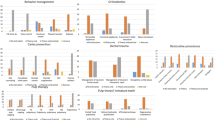Abstract
Aim: To gain an overview of knowledge of local analgesia, pulpal therapy and restorative procedures in the primary dentition amongst dental undergraduate students (DS), dental therapy students (DTS), recently-qualified dentists (QD) and dental therapists (DT), working within a Dental Hospital setting. Study Design: A survey undertaken at Dundee Dental Hospital and School, NHS Tayside, United Kingdom to determine current knowledge regarding the use of local analgesia, pulp anatomy and pulp therapy techniques in addition to restoration of primary teeth. Results: Data were available for 24 individuals (DS: 5; QD: 6; DTS: 8; DT: 5). Deficiencies in knowledge regarding the maximum safe dose for local analgesia, pulp canal anatomy, pulp therapy medicaments and the preparation required prior to placement of a pre-formed metal crown were noted in both student and staff groups. Conclusions: The knowledge of basic dental procedures for children amongst a group of dental students, student dental therapists and recently qualified dentists and dental therapists, was found to be imperfect. These findings indicate that more research is needed on the educational procedures used in the transfer of such knowledge and skills. Deficiencies in knowledge were identified in all areas assessed. Courses should be designed at both the pre- and postgraduate level to address and avoid such gaps in knowledge.
Similar content being viewed by others
References
Bedi R, Sutcliffe P, Donnan PT, McConnachie J. The prevalence of dental anxiety in a group of 13- and 14-year-old Scottish children. Int J Paediatr Dent 1992;2:17–24.
Cannell H. Evidence for safety margins of lignocaine local anaesthetics for peri-oral use. Br Dent J 1996;181:243–9.
Farsi N, Alamoudi N, Balto K, Mushayt A. Success of mineral trioxide aggre-gate in pulpotomized primary molars. J Clin Pediatr Dent 2005;29:307–11.
Fayle SA. UK National Clinical Guidelines in Paediatric Dentistry. Stainless steel preformed crowns for primary molars. Faculty of Dental Surgery, Royal College of Surgeons. Int J Paediatr Dent 1999;9:311–4.
Fayle SA, Welbury RR, Roberts JF. British Society of Paediatric Dentistry: a policy document on management of caries in the primary dentition. Int J Paediatr Dent 2001;11:153–7.
Finucane D, Nunn JH, O’Connell AC. Paediatric dentistry experience of the first cohort of students to graduate from Dublin Dental School and Hospital under the new curriculum. Int J Paediatr Dent 2004;14:402–8.
General Dental Council (2002).General Dental Council. Developing the Dental Team: Curricula Frameworks for Registrable Qualifications for Professionals Complementary to Dentistry (PCDs). 2004.
Ibricevic H, Al-Jame Q. Ferric sulphate and formocresol in pulpotomy of primary molars: long term follow-up study. Eur J Paediatr Dent 2003;4:28–32.
Innes NP, Stirrups DR, Evans DJ, Hall N, Leggate M. A novel technique using preformed metal crowns for managing carious primary molars in general practice — a retrospective analysis. Br Dent J 2006;200:451–4; discussion 444.
International Agency for Research on Cancer (2004) http://www.iarc.fr/ENG/Press_Releases/archives/pr153a.html.
Meechan JG, Robb ND, Seymour RA (1998) Pain and anxiety control for the conscious dental patient., Oxford.
Oulis CJ, Vadiakas GP, Vasilopoulou A. The effectiveness of mandibular infiltration compared to mandibular block anesthesia in treating primary molars in children. Pediatr Dent 1996;18:301–5.
Pitts NB, Boyles J, Nugent ZJ, Thomas N, Pine CM. The dental caries experience of 5-year-old children in England and Wales (2003/4) and in Scotland (2002/3). Surveys co-ordinated by the British Association for the Study of Community Dentistry. Community Dent Health 2005;22:46–56.
Qvist V, Laurberg L, Poulsen A, Teglers PT. Eight-year study on conventional glass ionomer and amalgam restorations in primary teeth. Acta Odontol Scand 2004;62:37–45.
Rodd HD, Waterhouse PJ, Fuks AB, Fayle SA, Moffat MA. Pulp therapy for primary molars. Int J Paediatr Dent 2006:15-23.
Scottish Intercollegiate Guidelines Network (2005). Prevention and control of dental caries in the pre-school child.
Sharaf AA. Evaluation of mandibular infiltration versus block anesthesia in pediatric dentistry. ASDC J Dent Child 1997;64:276–81.
Waterhouse PJ, Nunn JH, Whitworth JM. An investigation of the relative efficacy of Buckley’s Formocresol and calcium hydroxide in primary molar vital pulp therapy. Br Dent J 2000;188:32–6.
Author information
Authors and Affiliations
Corresponding author
Rights and permissions
About this article
Cite this article
Foley, J. A comparison of knowledge of local analgesia, pulp therapy and restoration of primary molar teeth amongst dental students, dentists and dental therapists within a Dental Hospital setting. Eur Arch Paediatr Dent 8, 113–117 (2007). https://doi.org/10.1007/BF03262579
Published:
Issue Date:
DOI: https://doi.org/10.1007/BF03262579




